Top speed 370 km/h Length 12 m First flight September 17, 1935 | Wingspan 15 m Introduced 1938 Manufacturer Vultee Aircraft | |
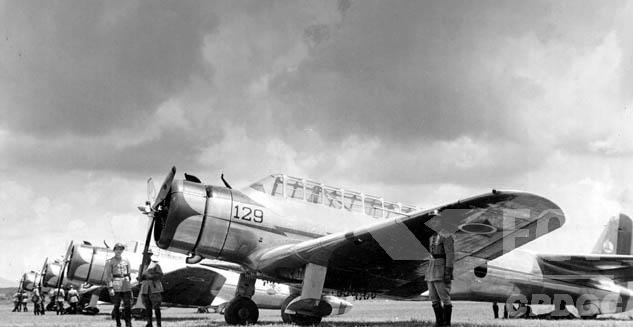 | ||
The Vultee V-11 and V-12 were American attack aircraft of the 1930s. Developed from the Vultee V-1 single-engined airliner, the V-11 and V-12 were purchased by several nation's armed forces, including China, who used them in combat against Japanese forces in the Second Sino-Japanese War. The United States Army Air Corps purchased seven V-11s as the YA-19 in the years before World War II, testing them to gather data to compare against twin engine light attack planes.
Contents
- Design and development
- China
- Brazil
- Soviet Union
- United States
- Variants
- Operators
- Specifications YA 19
- References
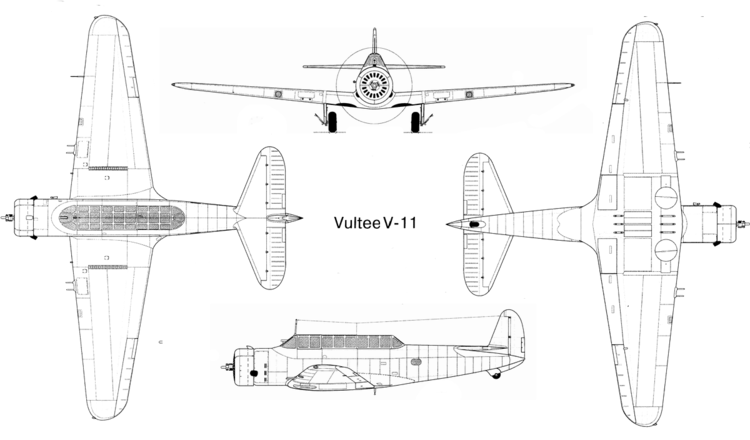
Design and development

In 1935, Vultee produced a light bomber derivative of their single-engined passenger transport, the Vultee V-1, which, while demonstrating good performance, was only sold in small numbers owing to restrictions placed on the use of single-engined aircraft for scheduled passenger transport operations.
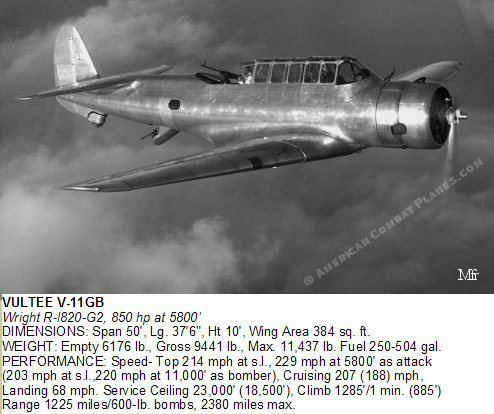
The resulting aircraft, the Vultee V-11, retained the single-engined, low wing format and all-metal stressed skin structure of the V-1. It combined a new fuselage with accommodation for the two or three crew members under a long greenhouse canopy with the wings and tail surfaces of the Vultee V-1.
China

An initial order for 30 two-seat V-11Gs was placed by China before the end of 1935. This was followed by orders in 1939 for two versions (the V-12-C and V-12D) of the more powerful V-12 variant. The majority of these were planned to be assembled from kits at the Central Aircraft Manufacturing Company factory at Loiwing near the China-Burma border, and while the first batch of 25 V-12-Cs were completed successfully, the factory was heavily bombed just after assembly of the first V-12-Ds commenced. This resulted in the part built airframes being evacuated to India, where it was planned that the aircraft be completed at the Hindustan Aircraft Limited factory in Bangalore. However, after a few were assembled, production was stopped as the factory was diverted to more urgent overhaul work.
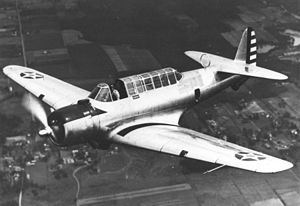
The V-11s and V-12s were used as light bombers and achieved some success, including a mission to bomb the Japanese held airfield by 4 aircraft at Yuncheng on February 5, 1939 by the 10th Squadron of the Republic of China Air Force, before the aircraft were withdrawn from bombing missions to training and liaison duties in 1940.
Brazil
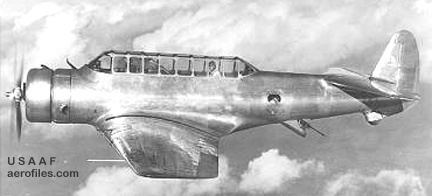
In February 1939 the Brazilian Army Air Corps acquired 10 Vultee V-11–GB2s for long range bombing. 26 aircraft were eventually used by the Brazilian Air Force.
On 8 November 1939, aircraft 119 performed a 3250 km non stop flight across the Brazilian hinterland in 11 hours and 45 min.
On 26 August 1942, a U-boat was attacked 50 miles off the town of Ararangua in southern Brazil. Despite the unsuitability for anti submarine operations, the aircraft flew low and dropped its load of three 250 lb bombs, some of which exploded around the submarine. A column of water and debris damaged the low flying aircraft.
Soviet Union
In 1936, the Soviet Union purchased four three-seat V-11-GB aircraft, together with a production license. The aircraft entered Soviet production in 1937 as the BSh-1 (Bronirovanny Shturmovik), but the armour fitted for the ground attack role unacceptably reduced performance and production was stopped after 31 aircraft. They were transferred to Aeroflot and redesignated PS-43 for use as high speed transports until the German invasion in 1941, when they were returned to the Air Force for liaison purposes.
United States
In the late 1930s, the United States Army Air Corps was favoring twin engine light attack aircraft but seven YA-19 aircraft were ordered in the summer of 1938 for comparison purposes. The YA-19s were armed with six .30 in (7.62 mm) machine guns and 1,080 lb (490 kg) bombs in an internal bomb bay, powered by a 1,200 hp (895 kW) Twin Wasp radial engine and was manned by a crew of three - pilot, observer/gunner, and bombardier/photographer.
An interesting feature of the YA-19 design was its horizontal stabiliser located forward of the vertical tail. The small size of the vertical stabilizer caused some directional instability (about the yaw axis) so the last YA-19 (S/N 38-555) was equipped with enlarged vertical stabilizer.
Service tests showed that twin engine attack aircraft were faster, could be better armed and carried a larger bomb load so no further YA-19s were ordered. After comparison tests five YA-19s were redesignated A-19 and assigned to the 17th Attack Group at March Field in California for a brief period before being transferred to the Panama Canal Zone for utility transport and liaison duties. The A-19 never saw combat and was quickly replaced in the early 1940s.
Variants
Operators
Info from Baugher
Specifications (YA-19)
Data from US Air Force Museum
General characteristics
Performance
Armament
